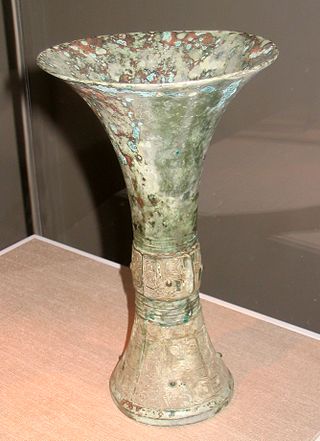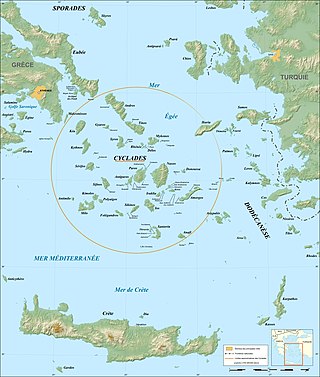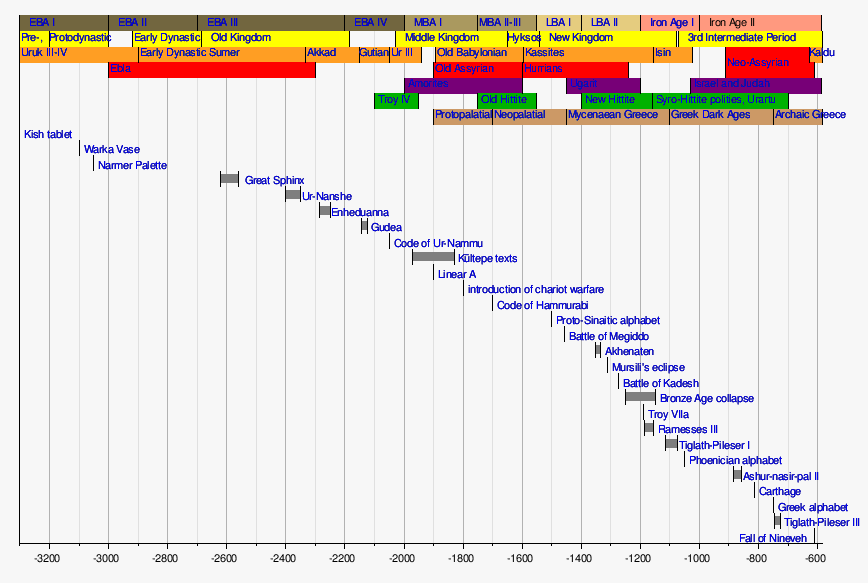The 2nd millennium BC spanned the years 2000 BC to 1001 BC. In the Ancient Near East, it marks the transition from the Middle to the Late Bronze Age. The Ancient Near Eastern cultures are well within the historical era: The first half of the millennium is dominated by the Middle Kingdom of Egypt and Babylonia. The alphabet develops. At the center of the millennium, a new order emerges with Mycenaean Greek dominance of the Aegean and the rise of the Hittite Empire. The end of the millennium sees the Bronze Age collapse and the transition to the Iron Age.
The 12th century BC is the period from 1200 to 1101 BC. The Late Bronze Age collapse in the ancient Near East and eastern Mediterranean is often considered to begin in this century.

The 13th century BC was the period from 1300 to 1201 BC.
The 1170s BC is a decade which lasted from 1179 BC to 1170 BC.

The Minoan civilization was a Bronze Age culture which was centered on the island of Crete. Known for its monumental architecture and energetic art, it is often regarded as the first civilization in Europe. The ruins of the Minoan palaces at Knossos and Phaistos are popular tourist attractions.

Cycladic culture was a Bronze Age culture found throughout the islands of the Cyclades in the Aegean Sea. In chronological terms, it is a relative dating system for artifacts which serves as a roughly contemporary dating system to Helladic chronology and Minoan chronology (Crete) during the same period of time.

Mycenaean Greece was the last phase of the Bronze Age in ancient Greece, spanning the period from approximately 1750 to 1050 BC. It represents the first advanced and distinctively Greek civilization in mainland Greece with its palatial states, urban organization, works of art, and writing system. The Mycenaeans were mainland Greek peoples who were likely stimulated by their contact with insular Minoan Crete and other Mediterranean cultures to develop a more sophisticated sociopolitical culture of their own. The most prominent site was Mycenae, after which the culture of this era is named. Other centers of power that emerged included Pylos, Tiryns, and Midea in the Peloponnese, Orchomenos, Thebes, and Athens in Central Greece, and Iolcos in Thessaly. Mycenaean settlements also appeared in Epirus, Macedonia, on islands in the Aegean Sea, on the south-west coast of Asia Minor, and on Cyprus, while Mycenaean-influenced settlements appeared in the Levant and Italy.
A palace economy or redistribution economy is a system of economic organization in which a substantial share of the wealth flows into the control of a centralized administration, the palace, and out from there to the general population. In turn the population may be allowed its own sources of income but relies heavily on the wealth distributed by the palace. It was traditionally justified on the principle that the palace was most capable of distributing wealth efficiently for the benefit of society. The temple economy is a similar concept.

Wilusa or Wilusiya was a Late Bronze Age city in western Anatolia known from references in fragmentary Hittite records. The city is notable for its identification with the archaeological site of Troy, and thus its potential connection to the legendary Trojan War.

Alashiya, also spelled Alasiya, also known as the Kingdom of Alashiya, was a state which existed in the Middle and Late Bronze Ages, and was situated somewhere in the Eastern Mediterranean. It was a major source of goods, especially copper, for ancient Egypt and other states in the Ancient Near East. It is referred to in a number of the surviving texts and is now thought to be the ancient name of Cyprus, or an area of Cyprus. This was confirmed by the scientific analysis performed in Tel Aviv University of the clay tablets which were sent from Alashiya to other rulers.

Anax is an ancient Greek word for "tribal chief, lord (military) leader". It is one of the two Greek titles traditionally translated as "king", the other being basileus, and is inherited from Mycenaean Greece. It is notably used in Homeric Greek, e.g. for Agamemnon. The feminine form is anassa, "queen".
Assuwa was a confederation of 22 states in western Anatolia around 1400 BC. The confederation formed to oppose the Hittite Empire, but was defeated under Tudhaliya I/II. The name was recorded in various centres in Mycenaean Greece as Asiwia, which later acquired the form Asia.
Troy in the Late Bronze Age was a thriving coastal city consisting of a steep fortified citadel and a sprawling lower town below it. It had a considerable population and extensive foreign contacts, including with Mycenaean Greece. Geographic and linguistic evidence suggests that it corresponds to the city of Wilusa known from Hittite texts. Its archaeological sublayers Troy VIh and Troy VIIa are among the candidates for a potential historical setting for the myths of the Trojan War, since aspects of their architecture are consistent with the Iliad's description of mythic Troy and they show potential signs of violent destruction.

The Late Bronze Age collapse was a time of widespread societal collapse during the 12th century BC associated with environmental change, mass migration, and the destruction of cities. The collapse affected a large area of the Eastern Mediterranean and the Near East, in particular Egypt, eastern Libya, the Balkans, the Aegean, Anatolia, and, to a lesser degree, the Caucasus. It was sudden, violent, and culturally disruptive for many Bronze Age civilizations, and it brought a sharp economic decline to regional powers, notably ushering in the Greek Dark Ages.

Minoan chronology is a framework of dates used to divide the history of the Minoan civilization. Two systems of relative chronology are used for the Minoans. One is based on sequences of pottery styles, while the other is based on the architectural phases of the Minoan palaces. These systems are often used alongside one another.

Eric H. Cline is an American author, historian, archaeologist, and professor of ancient history and archaeology at The George Washington University (GWU) in Washington, D.C., where he is Professor of Classics and Anthropology and the former Chair of the Department of Classical and Near Eastern Languages and Civilizations, as well as Director of the GWU Capitol Archaeological Institute. He is also the advisor for the undergraduate archaeology majors, for which he was awarded the GWU Award for "Excellence in Undergraduate Departmental Advising" (2006). Cline served as co-editor of the Bulletin of the American Schools of Oriental Research along with Christopher Rollston from 2014–2020.
The Middle Bronze Age Migrations are postulated waves of migration during the Middle Bronze Age. This proposal was advanced in the mid-20th century by scholars such as Mellaart, who argued for a connection between the spread of the Indo-European languages and archaeologically attested destructions and cultural changes around the 20th century BC. However, more recent research has disfavored the notion of Indo-European invasions, interpreting the evidence as favoring a more gradual process of assimilation.

The Achaeans were one of the four major tribes into which Herodotus divided the Greeks, along with the Aeolians, Ionians and Dorians. They inhabited the region of Achaea in the northern Peloponnese, and played an active role in the colonization of Italy, founding the city of Kroton. Unlike the other major tribes, the Achaeans did not have a separate dialect in the Classical period, instead using a form of Doric.

The prehistory of Anatolia stretches from the Paleolithic era through to the appearance of classical civilisation in the middle of the 1st millennium BC. It is generally regarded as being divided into three ages reflecting the dominant materials used for the making of domestic implements and weapons: Stone Age, Bronze Age and Iron Age. The term Copper Age (Chalcolithic) is used to denote the period straddling the stone and Bronze Ages.

The military nature of Mycenaean Greece in the Late Bronze Age is evident by the numerous weapons unearthed, warrior and combat representations in contemporary art, as well as by the preserved Greek Linear B records. The Mycenaeans invested in the development of military infrastructure with military production and logistics being supervised directly from the palatial centres.













